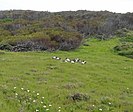
Robben Island
Robben Island (Afrikaans: Robbeneiland) is an island in Table Bay, 6.9 kilometres (4.3 mi) west of the coast of Bloubergstrand, north of Cape Town, South Africa. It takes its name from the Dutch word for seals (robben), hence the Dutch/Afrikaans name Robbeneiland, which translates to Seal(s) Island.
For the prison, see Robben Island (prison).
Robben Island
Robbeneiland
5.18 km2 (2.00 sq mi)
116
22/km2 (58/sq mi)
60.3%
23.3%
13.8%
2.6%
37.9%
35.3%
15.5%
7.8%
3.4%
Cultural
III, VI
1999 (23rd session)
Robben Island is roughly oval in shape, 3.3 kilometres (2 miles) long north–south, and 1.9 km (1+1⁄8 mi) wide, with an area of 5.08 km2 (1+31⁄32 sq mi).[2] It is flat and only a few metres above sea level, as a result of an ancient erosion event. It was fortified and used as a prison from the late-seventeenth century until 1996, after the end of apartheid.
Political activist and lawyer Nelson Mandela was imprisoned on the island for 18 of the 27 years of his imprisonment before the fall of apartheid and introduction of full, multi-racial democracy. He was later awarded the Nobel Peace Prize and was elected in 1994 as President of South Africa, becoming the country's first black president and serving one term from 1994 to 1999. In addition, the majority of prisoners were detained here for political reasons. Two other former inmates of Robben Island, in addition to Mandela, have been elected to the presidency since the late-1990s: Kgalema Motlanthe (2008–2009)[3] and Jacob Zuma (2009–2018).
Robben Island is a South African National Heritage Site as well as a UNESCO World Heritage Site.[4][5]
Access to the island[edit]
Robben Island is accessible to visitors through tours that depart from Cape Town's waterfront.[20] Tours depart three times a day and take about 3.5 hours, consisting of a ferry trip to and from the island, and a tour of the various historical sites on the island that form part of the Robben Island Museum. These include the island graveyard, the disused lime quarry, Robert Sobukwe's house, the Bluestone quarry, the army and navy bunkers, and the maximum security prison. Nelson Mandela's cell is shown.[21]





